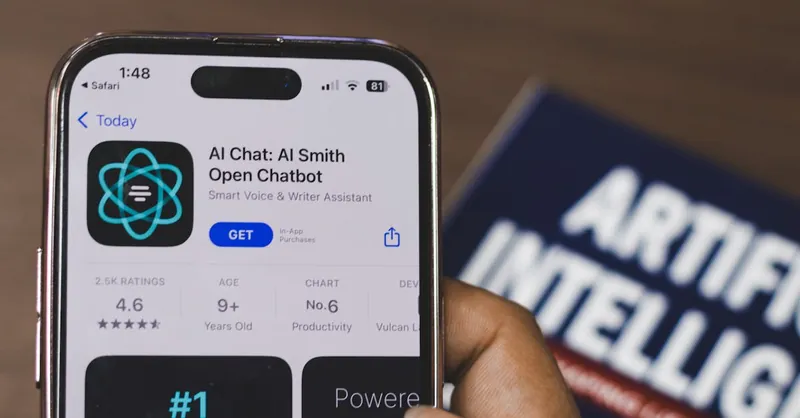Using AI to Automate Daily Tasks for Maximum Productivity
Category: Productivity & Automation
Unlocking Productivity with AI-Powered Automation
If you’re a professional, entrepreneur, or tech enthusiast, you already recognize that time is an invaluable resource. Yet, the endless cycle of daily repetitive tasks can often drain your energy and blur your focus on what truly drives your success. That's likely why you're here—seeking a smarter, hands-off approach to streamline your workflow. This post dives deep into how AI can revolutionize the way you tackle everyday tasks, allowing you to reclaim your time and amplify your productivity. Unlike generic automation advice, we focus on practical, real-world AI applications tailored for busy individuals who demand efficiency without sacrificing quality. Whether you're managing emails, scheduling, data entry, or customer follow-ups, you'll discover actionable strategies that harness cutting-edge AI tools and technologies. By the end, you’ll know exactly how to identify suitable tasks for automation, select the right AI solutions, and implement them seamlessly into your routine. If you’re ready to move beyond manual grind and start working smarter, not harder, this comprehensive guide is your first step.
- Unlocking Productivity with AI-Powered Automation
- Understanding AI Automation
- Identifying Daily Tasks Suitable for AI Automation
- Top AI Tools to Automate Communication
- AI for Scheduling and Calendar Management
- Automating Data Handling and Reporting with AI
- Leveraging AI in Customer Relationship Management (CRM)
- Streamlining Financial Tasks Through AI Automation
- Integrating AI Automation into Your Workflow
- Addressing Challenges and Ethical Considerations in AI Automation
- Future Trends: Evolving AI Automation for Daily Tasks
Understanding AI Automation
At its core, AI-driven automation represents a significant leap beyond traditional automation by combining machine learning, natural language processing, and cognitive computing to perform tasks that typically require human intelligence. While traditional automation relies on scripted, rule-based processes designed for repetitive, predictable tasks, AI automation dynamically learns from data, adapts to new patterns, and makes decisions with minimal human intervention.
Unlike basic automation tools that follow fixed instructions, AI-powered systems continuously improve through experience—analyzing input data, recognizing contextual nuances, and handling complex workflows such as email prioritization, customer sentiment analysis, or personalized scheduling. This adaptive quality allows AI to automate not just simple tasks but also multifaceted daily activities that involve variability and unpredictability, making it indispensable for professionals striving to boost efficiency without compromising flexibility. By embracing AI automation, you unlock smarter workflows that evolve alongside your needs, transforming how you manage your time and resources every day.

Image courtesy of Sanket Mishra
Identifying Daily Tasks Suitable for AI Automation
To harness AI-driven automation effectively, the first step is to evaluate and prioritize daily tasks that are repetitive, time-consuming, and prone to human error. In both personal and professional settings, tasks ideal for AI automation share specific characteristics: they involve high volumes of routine actions, clear patterns or rules, and minimal need for complex human judgment. By focusing on these tasks, you can maximize the return on investment from AI tools while freeing up valuable time for more strategic activities.
How to Identify Ideal Candidates for AI Automation
Consider these key factors when assessing which daily tasks to automate:
- Repetitiveness: Tasks performed frequently with little variation—such as data entry, email sorting, or invoice processing—are prime candidates.
- Predictability: Activities with consistent workflows and clear decision trees can be easily mapped for AI systems to handle.
- High Volume: Automating tasks that occur regularly on a large scale amplifies efficiency gains.
- Manual Effort: Jobs that consume disproportionate amounts of your energy but add minimal strategic value, like scheduling or follow-ups, can be offloaded to AI.
- Error-Prone: Processes susceptible to human mistakes, such as transcription or form filling, benefit greatly from AI accuracy.
- Data Intensity: Tasks that require analyzing and organizing large data sets, for example, customer segmentation or expense tracking, are perfect for AI’s analytical capabilities.
Prioritizing Tasks for Maximum Impact
Once you have identified potential automation candidates, prioritize them based on:
- Time savings potential: Estimate the hours saved per week by automating each task.
- Complexity of automation: Start with simpler tasks that require minimal setup to build momentum.
- Integration feasibility: Ensure the AI solution can smoothly integrate with your existing tools and workflows.
- Impact on productivity: Focus on automating tasks that free you to concentrate on high-value work such as decision-making or creativity.
By systematically analyzing your daily routine through this lens, you create a strategic roadmap to implement AI automation that truly elevates your productivity. This evaluation process ensures you invest time and resources into automating the right tasks—turning repetitive chores into seamless, intelligent workflows that continuously adapt and improve.

Image courtesy of Matheus Bertelli
Top AI Tools to Automate Communication
Effective communication is a cornerstone of productivity, yet managing emails, social media, and customer interactions can consume a disproportionate amount of your time. Thankfully, AI-powered communication tools are transforming how individuals and businesses stay responsive, organized, and connected without the constant manual effort. By leveraging AI for communication automation, you can dramatically reduce response times, improve accuracy, and free yourself to focus on more strategic priorities.
AI Applications for Email Management
Email overload is a common productivity killer, but AI tools like Superhuman, SaneBox, and Google’s Smart Compose use machine learning to prioritize important messages, suggest relevant replies, and even schedule emails to go out at optimal times. These tools help you:
- Automatically categorize and filter incoming mail.
- Generate context-aware responses.
- Set reminders and follow-ups without manual tracking.
- Reduce the cognitive load of inbox management.
Conversational AI: Chatbots and Virtual Assistants
For businesses and busy individuals alike, AI-driven chatbots and virtual assistants such as Drift, Intercom, and x.ai are revolutionizing real-time communication. These tools can:
- Handle FAQs or common customer service requests 24/7.
- Schedule meetings and manage calendars based on your availability.
- Qualify leads or gather initial information before routing to a human agent.
- Provide personalized, conversational experiences that increase engagement without requiring constant human monitoring.
Streamlining Social Media Interactions with AI
Managing social media traffic is another repetitive task ripe for automation. Tools like Buffer Reply, Hootsuite Insights, and Cortex leverage AI to:
- Aggregate comments, messages, and mentions into a unified inbox.
- Prioritize responses based on sentiment and urgency.
- Generate suggested replies to speed up engagement.
- Analyze interaction trends to optimize posting schedules and content strategies.
By integrating these AI communication tools into your daily workflow, you ensure that no message goes unanswered, your email stays manageable, and your online presence remains active—all while saving precious time. This automated communication framework not only boosts productivity but also enhances responsiveness and builds stronger relationships effortlessly.

Image courtesy of Matheus Bertelli
AI for Scheduling and Calendar Management
Streamlining scheduling and calendar management with AI is one of the most impactful ways to reduce daily friction and boost productivity. AI-powered scheduling tools can dynamically optimize appointment bookings, send timely reminders, and implement intelligent time blocking, all designed to minimize no-shows and maximize the efficient use of your working hours. Instead of the traditional back-and-forth email chains, AI assistants like Calendly, x.ai, and Clara Labs automate meeting coordination by analyzing participants' availability, suggesting optimal times, and instantly syncing calendars across platforms.
Beyond simple booking, AI enhances time management through smart reminders that reduce forgetfulness and ensure preparation for upcoming events. More sophisticated systems apply time blocking algorithms that prioritize tasks based on urgency and your productivity patterns, automatically carving out focused work periods while avoiding overcommitment. This holistic AI approach to calendar management not only eliminates scheduling conflicts but also helps maintain a balanced workflow, preventing burnout and increasing overall planning efficiency. By entrusting your calendar to AI, you gain consistent control over your time and create space to focus on high-value activities that power your success.

Image courtesy of RDNE Stock project
Automating Data Handling and Reporting with AI
One of the most time-consuming and error-prone aspects of daily work involves data entry, extraction, analysis, and report generation. Leveraging AI-powered solutions to automate these processes can dramatically reduce human mistakes, save hours of manual labor, and enable faster, more informed decision-making. Modern AI tools excel in recognizing patterns within unstructured data, extracting relevant information from documents, and transforming raw data into actionable insights—all with minimal human intervention.
AI-Powered Data Entry and Extraction
AI-driven Optical Character Recognition (OCR) and Natural Language Processing (NLP) tools can automatically scan invoices, forms, emails, and PDFs to extract key information such as dates, amounts, names, and other critical fields. This eliminates tedious manual data entry while significantly improving accuracy. Tools like UiPath, Automation Anywhere, and ABBYY FlexiCapture integrate AI capabilities to autonomously process large volumes of diverse documents, seamlessly feeding clean data into your systems and databases.
Streamlining Data Analysis and Insights
Beyond data capture, AI analytics platforms such as Power BI, Tableau (with AI integration), and Google Data Studio leverage machine learning algorithms to identify trends, anomalies, and correlations within your datasets. These platforms can also generate predictive insights, empowering you to proactively address challenges and optimize workflows. Automated dashboards update in real-time, giving you a comprehensive view of your key performance indicators without the need for manual compilation or interpretation.
Automated Report Generation for Enhanced Productivity
One of the most powerful benefits of AI in data handling is automated report generation. AI tools can draft comprehensive reports tailored to your specifications, summarizing complex data into clear narratives, charts, and visualizations. Solutions like Narrative Science Quill and Automated Insights Wordsmith transform raw data analyses into written reports that can be customized for different stakeholders, ensuring decision-makers receive timely, relevant information with minimal effort on your part.
By incorporating these AI technologies into your daily workflow, you minimize errors, accelerate data processing times, and unlock deeper insights, ultimately freeing you to focus on higher-value strategic activities. Automating data handling and reporting serves as a cornerstone for any productivity-focused professional aiming to harness AI’s full potential in managing information efficiently and effectively.

Image courtesy of Mikael Blomkvist
Leveraging AI in Customer Relationship Management (CRM)
In today’s competitive business landscape, maintaining strong, personalized relationships with customers is crucial—but it can be time-consuming and complex. AI-powered CRM systems revolutionize how businesses manage interactions by automating customer follow-ups, personalizing outreach, and tracking engagement metrics in real time. These intelligent CRM tools combine machine learning and natural language processing to not only streamline routine tasks but also deliver highly relevant communication that resonates with individual customers, driving loyalty and sales.
Automating Customer Follow-Ups with AI
One of the most valuable AI applications in CRM is automated customer follow-up. AI algorithms analyze past interactions, purchase history, and engagement patterns to schedule timely follow-ups without manual input. This ensures no lead or client falls through the cracks, increasing conversion rates and nurturing long-term relationships. AI chatbots and virtual assistants can also handle initial outreach, qualify prospects, and escalate high-value conversations to human agents only when necessary, further optimizing your sales and support workflows.
Personalized Outreach at Scale
Personalization is key to impactful customer engagement, but manually crafting tailored messages for large customer bases is impractical. AI-driven CRM platforms use predictive analytics and customer segmentation to generate customized email campaigns, offers, and recommendations that align with each client’s preferences and behaviors. These systems dynamically adapt messaging based on customer responses and interactions, enhancing relevance and boosting open and click-through rates.
Real-Time Engagement Tracking and Insights
Beyond automation, AI-enhanced CRM solutions provide deep engagement tracking, analyzing communication sentiment, frequency, and customer feedback across multiple channels. This actionable intelligence helps businesses identify high-potential leads, detect churn risks, and optimize interaction strategies proactively. Dashboards powered by AI aggregate these insights, enabling sales and marketing teams to make data-driven decisions that improve customer satisfaction and lifetime value.
By integrating AI into your CRM, you transform traditional customer management into a smart, adaptive system that automates tedious processes, personalizes outreach effortlessly, and provides continuous visibility into customer engagement. This not only elevates productivity but also enhances the overall quality of business interactions, giving you a competitive edge in building lasting relationships.

Image courtesy of Pavel Danilyuk
Streamlining Financial Tasks Through AI Automation
Managing finances can be one of the most tedious and error-prone aspects of running a business or handling personal budgeting. Fortunately, AI-powered financial automation tools are transforming how invoicing, expense tracking, payroll, and budget forecasting are handled—significantly reducing your administrative burden while improving accuracy and compliance. By automating these core financial tasks, AI enables professionals to focus on growth and strategic decision-making rather than manual number crunching.
AI for Smart Invoicing and Expense Tracking
Automated invoicing solutions use AI to generate, send, and follow up on invoices based on your sales data and client activities. Tools like FreshBooks AI, Zoho Invoice, and QuickBooks Online leverage machine learning to:
- Automatically create invoices from order or project details.
- Detect late payments and trigger reminders without manual intervention.
- Categorize and reconcile expenses by analyzing receipts and bank transactions through AI-powered OCR, eliminating manual data entry and reducing errors.
These features streamline cash flow management and ensure your accounts remain accurate and up-to-date with minimal effort.
Automating Payroll Processing
Payroll management is often complex due to variable hours, tax regulations, and benefits administration. AI-enhanced payroll platforms such as Gusto, OnPay, and ADP Workforce Now take over this complexity by:
- Calculating employee wages, tax withholdings, and deductions automatically.
- Ensuring compliance with ever-changing tax laws using AI-driven rule updates.
- Processing payments on schedule and generating pay stubs and tax forms without human oversight.
By automating payroll, you reduce the risk of costly errors while saving significant administrative time each pay cycle.
AI-Driven Budget Forecasting and Financial Planning
Accurate budget forecasting is essential for sustainable growth but requires analyzing large volumes of financial data and market variables. AI-powered forecasting tools like Fathom Analytics, Planful, and Adaptive Insights leverage machine learning algorithms to:
- Analyze historical spending, income trends, and seasonal fluctuations.
- Predict future cash flows, expenses, and revenue with greater precision.
- Provide scenario-based budgeting models to help you quickly adjust plans based on different assumptions or economic conditions.
This level of AI-driven financial insight empowers you to make proactive decisions and avoid cash surprises, effectively turning your financial management into a strategic advantage.
By integrating AI automation into your financial workflows, you eliminate manual errors, expedite routine processes, and gain predictive intelligence that enhances both everyday operations and long-term planning. Embracing these AI tools fundamentally transforms financial task management, helping professionals and businesses save time, reduce stress, and increase overall productivity.

Image courtesy of Pavel Danilyuk
Integrating AI Automation into Your Workflow
Successfully incorporating AI automation into your existing workflow requires a strategic, gradual approach that minimizes disruption while maximizing benefits. Instead of overhauling your entire process at once, start by piloting AI tools on select tasks that have already been identified as suitable for automation. This method allows you to gain hands-on experience, build confidence, and refine automation strategies before wider deployment.
Practical Steps for Gradual AI Implementation
- Choose Low-Risk, High-Reward Tasks: Begin with repetitive, well-defined activities where AI can quickly demonstrate value—such as email filtering, calendar scheduling, or invoice processing.
- Select Compatible AI Tools: Prioritize AI solutions that seamlessly integrate with your current software stack to avoid workflow interruptions and additional training overhead.
- Set Clear Goals and KPIs: Define specific success metrics such as time saved, error rate reduction, or customer response times to objectively evaluate AI impact.
- Train Your Team: Provide necessary training and resources to ensure smooth adoption and to address any resistance or skill gaps related to new AI tools.
- Monitor and Iterate: Continuously track performance against KPIs, gather user feedback, and fine-tune AI configurations to improve efficiency and adapt to changing needs.
Measuring ROI and Ensuring Long-Term Success
Maximizing the return on investment (ROI) from AI automation involves regularly assessing both quantitative and qualitative outcomes. Track tangible metrics like reduced processing times, cost savings, and error reductions alongside softer benefits such as enhanced employee satisfaction and improved customer experiences.
- Use analytics dashboards or built-in AI reporting features to monitor productivity gains.
- Compare pre- and post-automation workflows to evaluate time freed for creative or strategic tasks.
- Calculate cost savings from lowered manual labor or decreased operational errors.
- Remain vigilant about AI performance and marketplace developments to adopt upgrades or new features that maintain your competitive edge.
By embedding AI automation progressively and measuring its impact rigorously, you create a scalable productivity ecosystem that evolves in tandem with your professional goals and organizational growth. This balanced integration strategy ensures AI tools amplify your efficiency without disrupting existing workflows, delivering sustainable value and empowering you to achieve more with less effort.

Image courtesy of Pavel Danilyuk
Addressing Challenges and Ethical Considerations in AI Automation
While AI automation offers transformative productivity benefits, it is essential to recognize and proactively address potential challenges and ethical considerations that come with integrating AI into daily workflows. One of the foremost concerns is data privacy and security. AI systems often require access to sensitive personal or business data to function effectively, making them vulnerable to data breaches, unauthorized use, or compliance violations. Ensuring robust data protection protocols, encryption, and adherence to privacy regulations such as GDPR or CCPA is critical to maintain trust and legal compliance when deploying AI tools.
Another significant risk is the potential for overreliance on AI automation, which can lead to diminished human judgment and critical thinking. Relying excessively on AI decisions without ongoing human oversight may result in unchecked errors, biased outcomes, or missed contextual nuances that only humans can detect. To mitigate this, it is vital to maintain active human supervision in the AI workflow, regularly reviewing outputs, validating automated decisions, and retaining human authority over crucial tasks.
Furthermore, ethical considerations such as algorithmic bias, transparency, and accountability must be central to your AI strategy. AI models trained on biased or incomplete data can perpetuate unfair outcomes, affecting both individuals and organizational decision-making. Promoting transparency by understanding AI processes, setting clear ethical guidelines, and choosing vendors committed to responsible AI use ensures your automation efforts are both productive and principled.
By addressing these challenges upfront with a focus on data security, balanced human-AI collaboration, and ethical governance, you create a sustainable, trustworthy AI automation environment that maximizes productivity without compromising integrity or control. This balanced approach safeguards your workflow from common pitfalls and aligns AI adoption with best practices in privacy and ethics.

Image courtesy of Markus Winkler
Future Trends: Evolving AI Automation for Daily Tasks
As AI technology continues to advance at a rapid pace, the future of AI automation for daily tasks promises even greater efficiency, personalization, and adaptability. Emerging innovations such as generative AI, autonomous agents, and context-aware systems are set to reshape how individuals and businesses automate routine workflows, enabling smarter, more intuitive interactions that go beyond today’s capabilities.
Key Emerging AI Technologies Shaping Tomorrow’s Automation
-
Generative AI Models: Building on breakthroughs like GPT-4 and beyond, generative AI can create customized content, draft complex reports, and generate contextual responses autonomously. This ability to produce high-quality text, images, or code on demand will significantly expand automation beyond simple repetitive tasks into creative and knowledge work.
-
Autonomous AI Agents: These intelligent agents will act independently to manage workflows, coordinate between different applications, and make decisions based on real-time data. By autonomously handling multi-step tasks such as project management, personalized customer engagement, or dynamic scheduling, autonomous AI will increase productivity by reducing the need for constant human supervision.
-
Context-Aware and Adaptive Systems: Future AI automation will leverage deeper contextual understanding, including emotional tone, user habits, and environmental factors, enabling more personalized and relevant task execution. This evolution will optimize how AI manages communications, prioritizes notifications, and anticipates user needs, delivering seamless and frictionless productivity support.
How These Trends Empower You to Stay Ahead
To harness the power of evolving AI automation technologies, staying informed and proactive is essential. Key strategies include:
- Continuous Learning: Regularly explore new AI tools and updates that incorporate these emerging technologies to keep your automation workflows cutting-edge.
- Flexible Integration: Adopt AI platforms that support modular upgrades, allowing you to incorporate next-generation AI capabilities without disrupting existing processes.
- Experimentation and Feedback: Pilot innovative AI solutions on less critical tasks to evaluate their effectiveness and tailor them for your unique requirements.
By anticipating and embracing these future trends in AI automation, you position yourself to unlock unprecedented levels of productivity, maintain a competitive edge, and navigate the dynamic digital landscape with confidence. Harnessing next-generation AI not only optimizes daily task management but also empowers you to innovate your workflow continually, achieving more with less effort as technology evolves.

Image courtesy of Pavel Danilyuk
